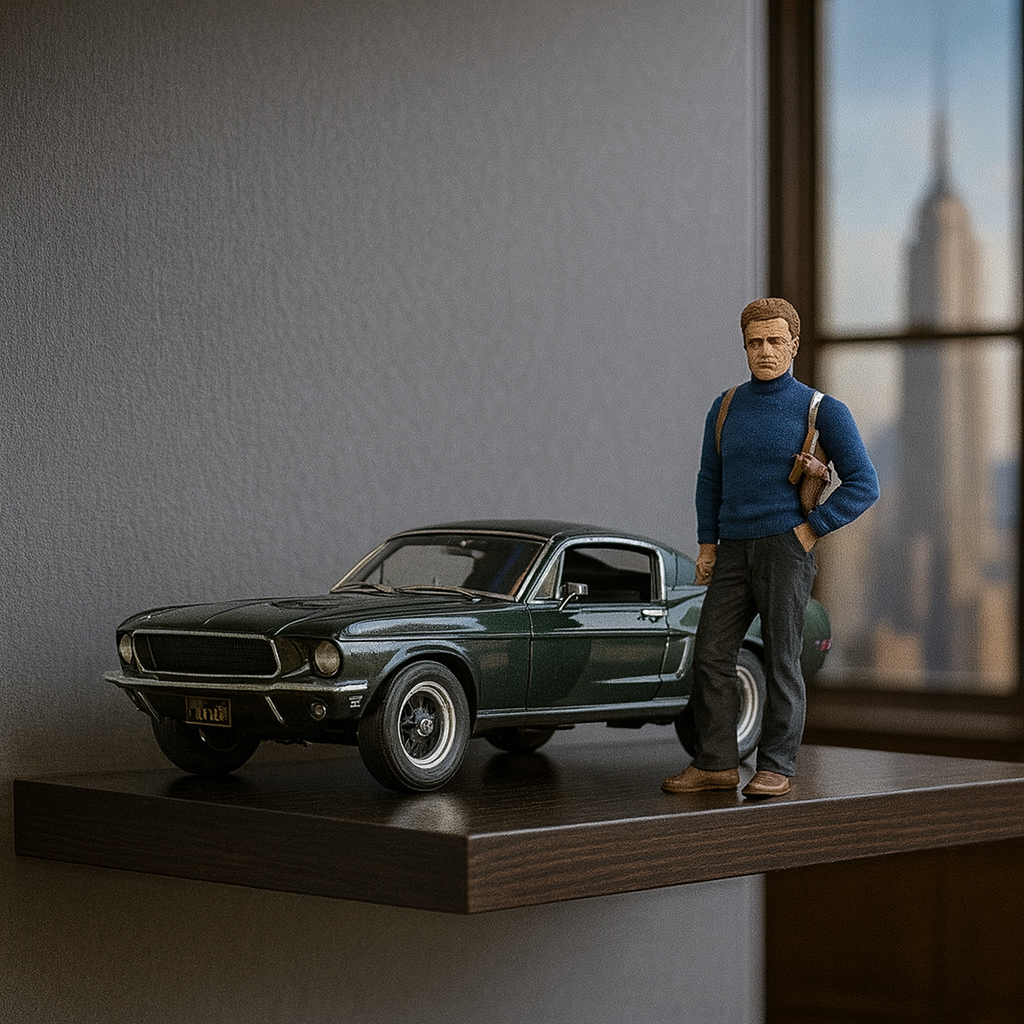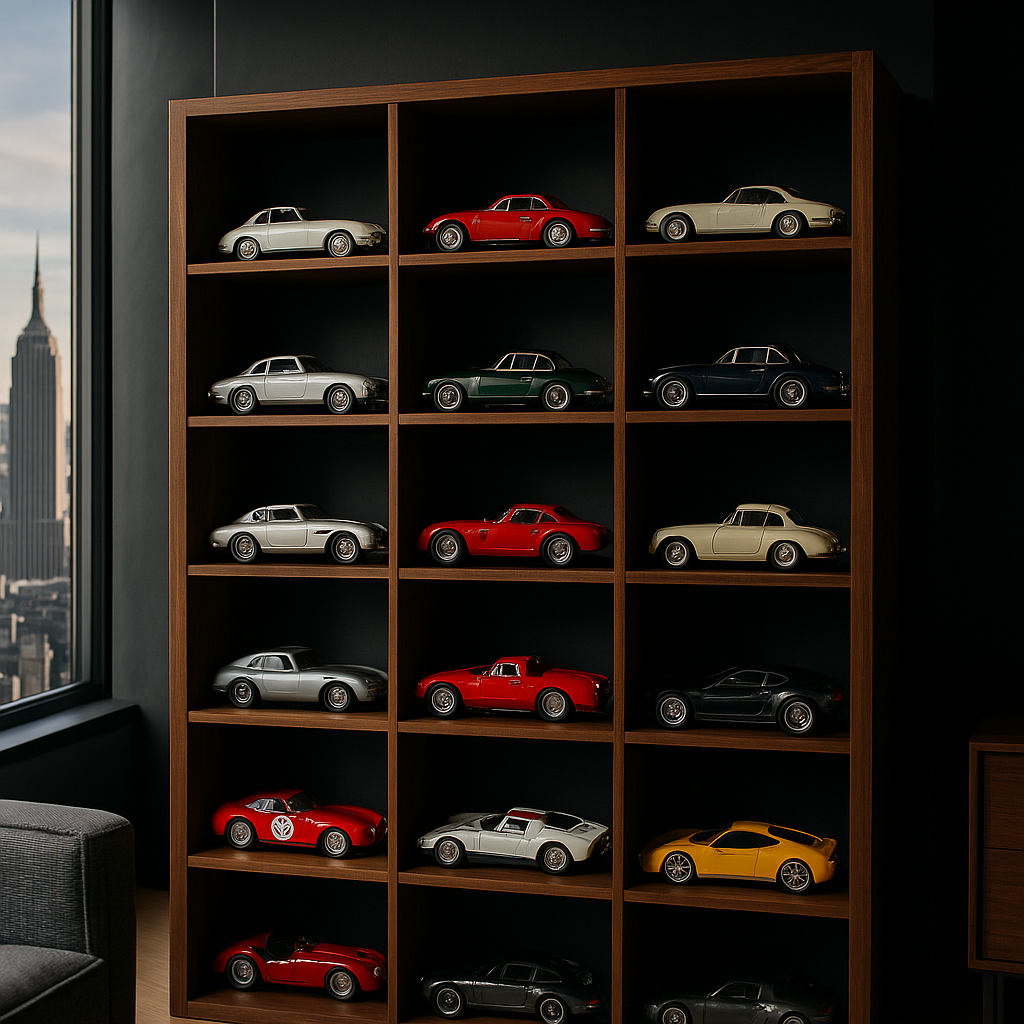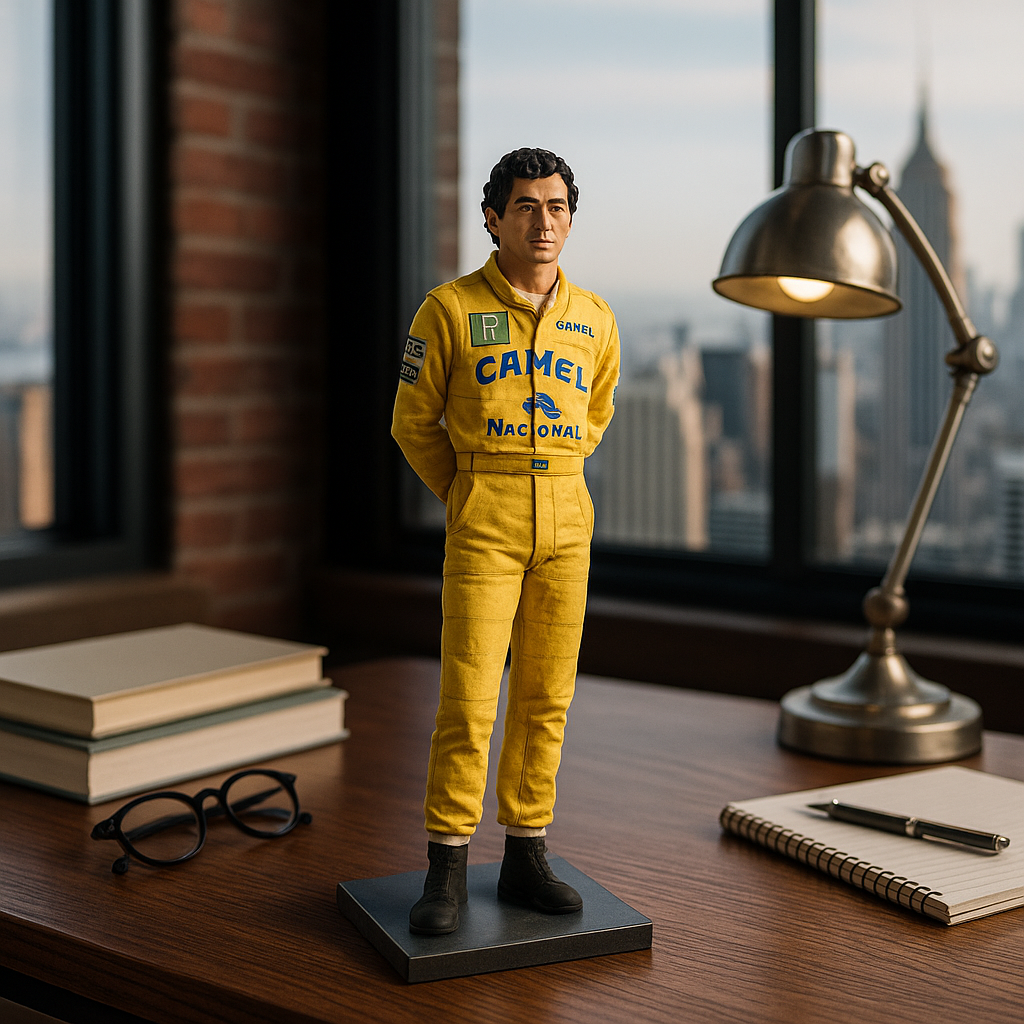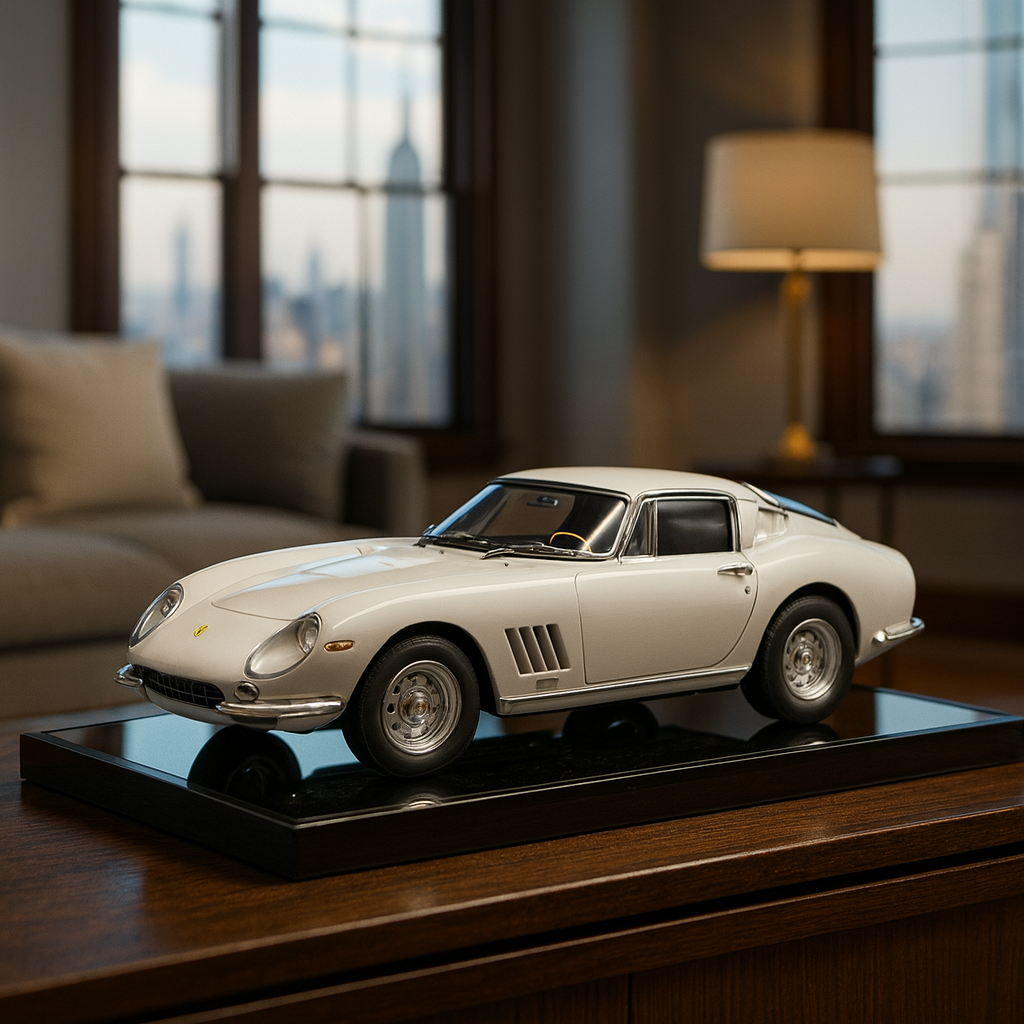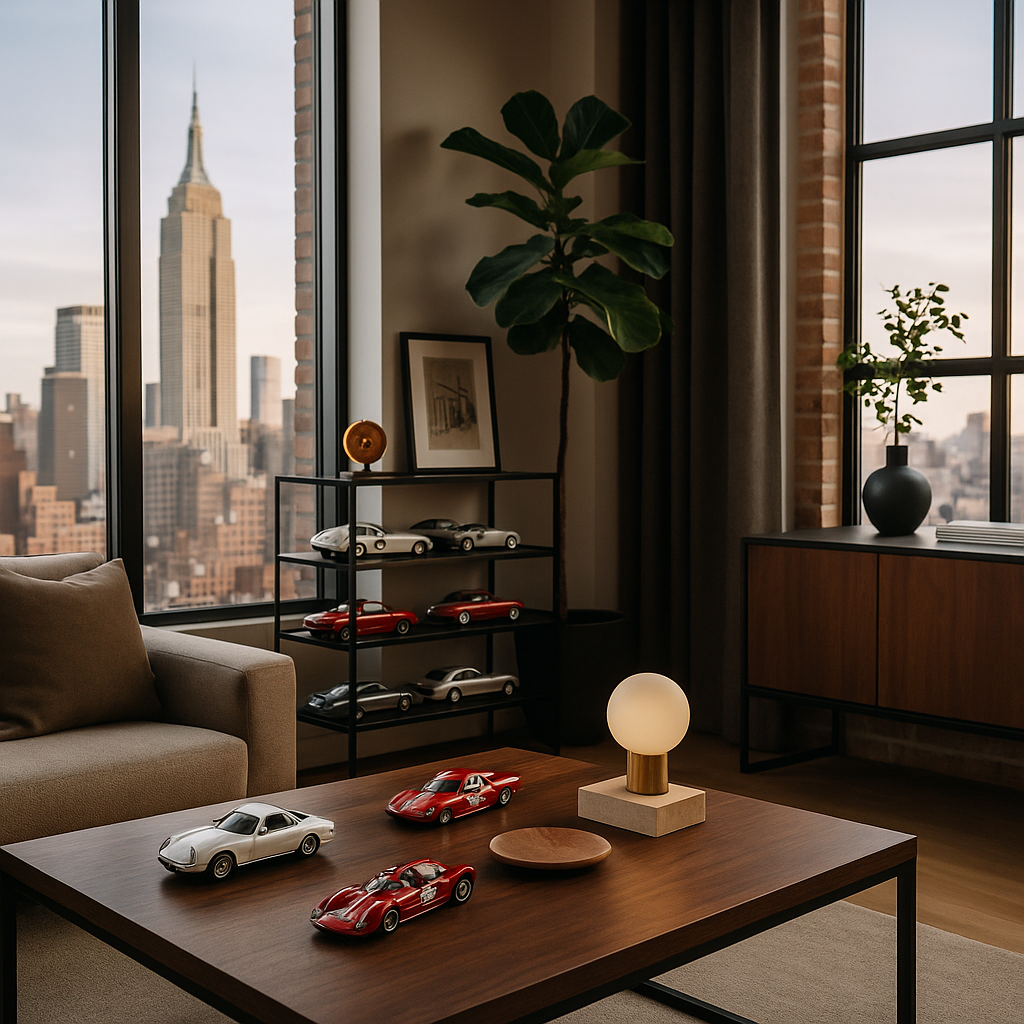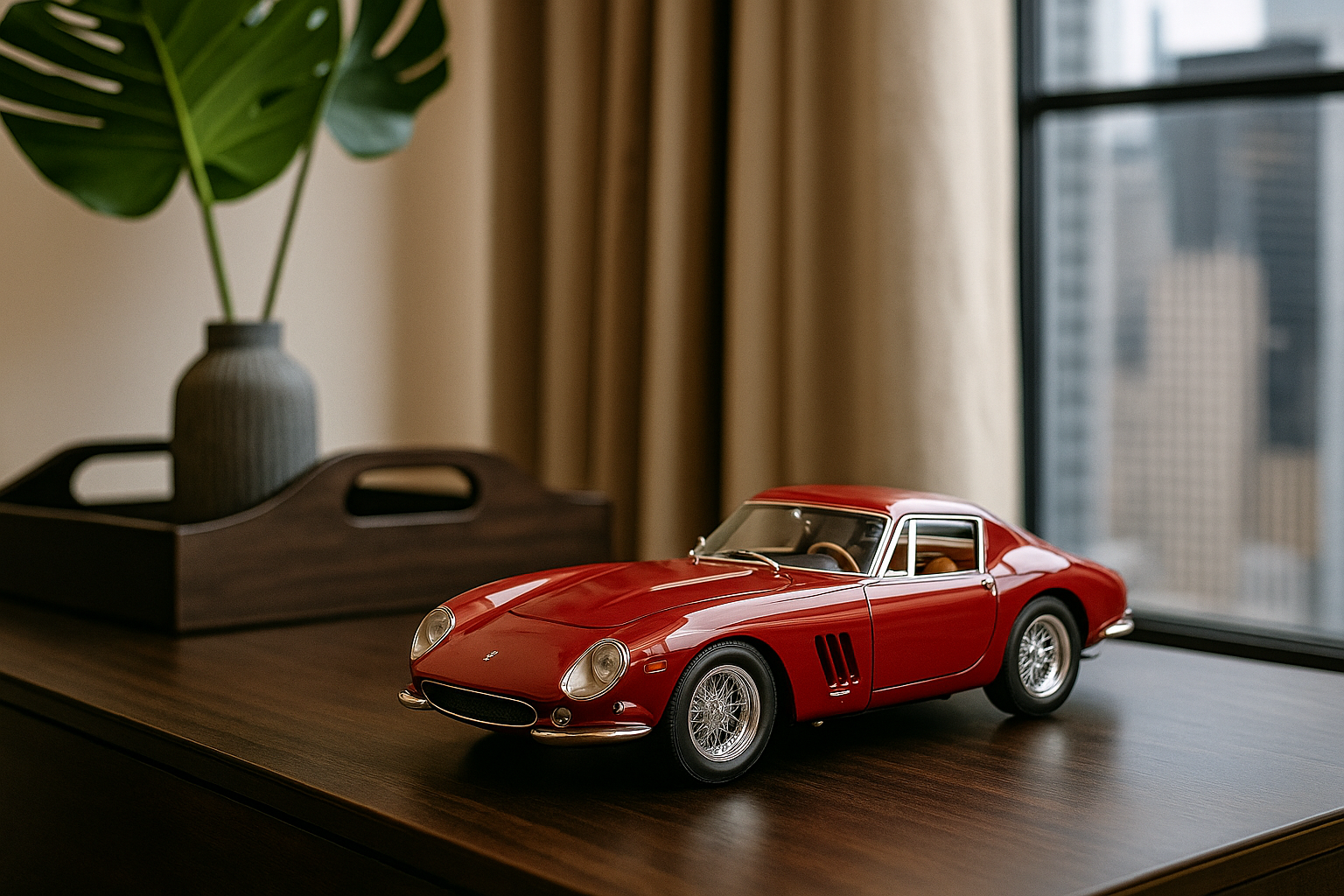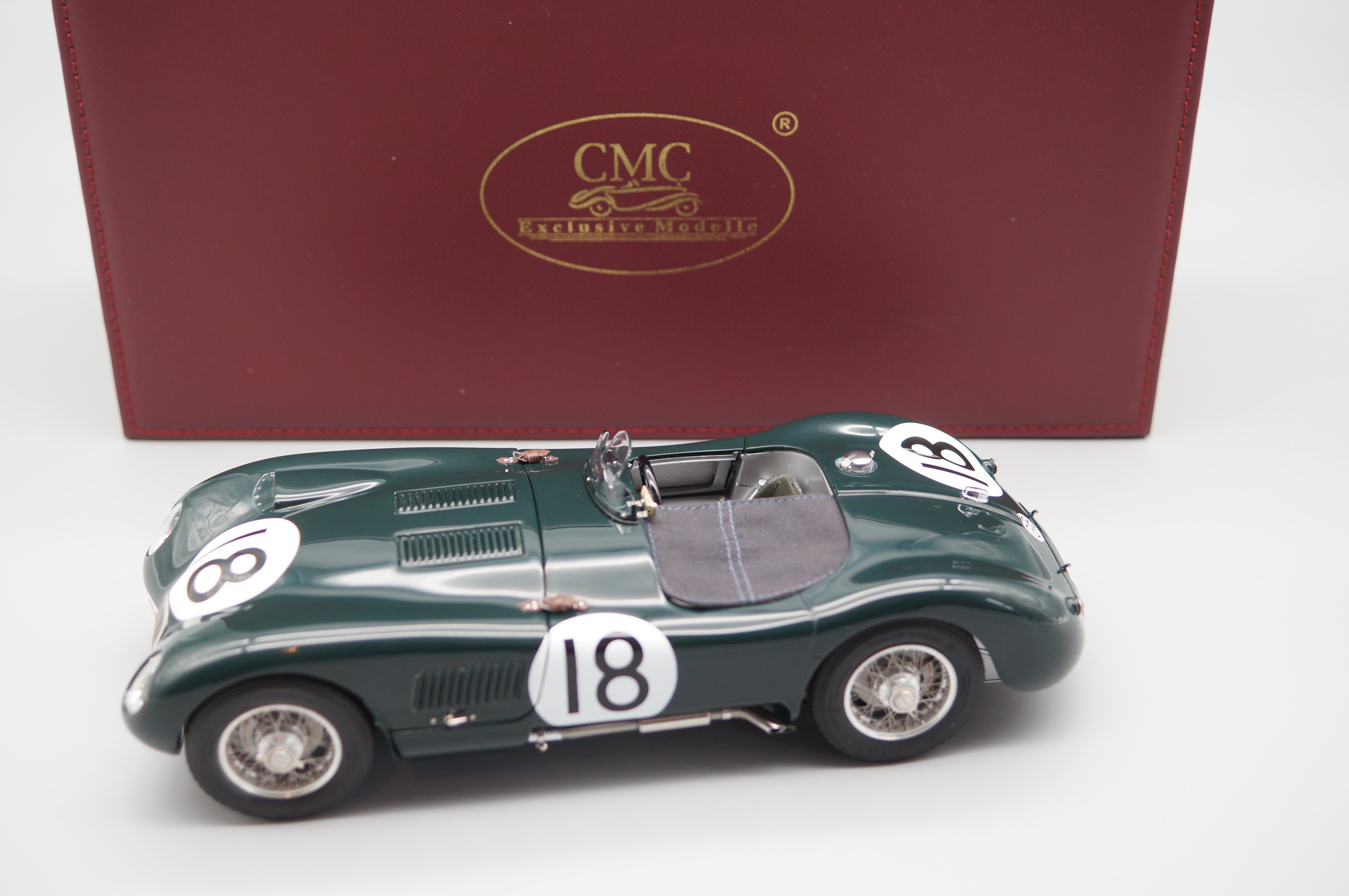
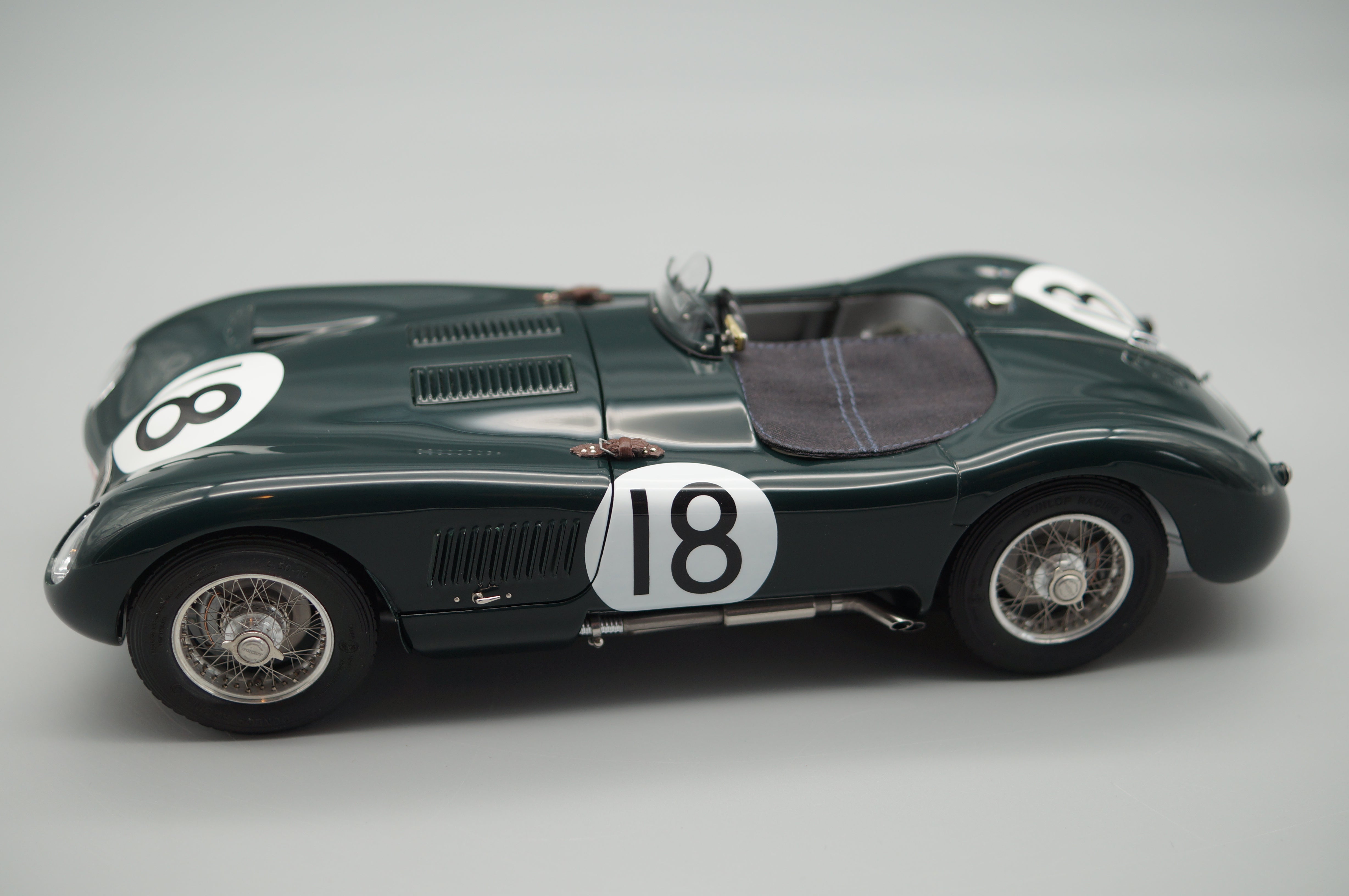
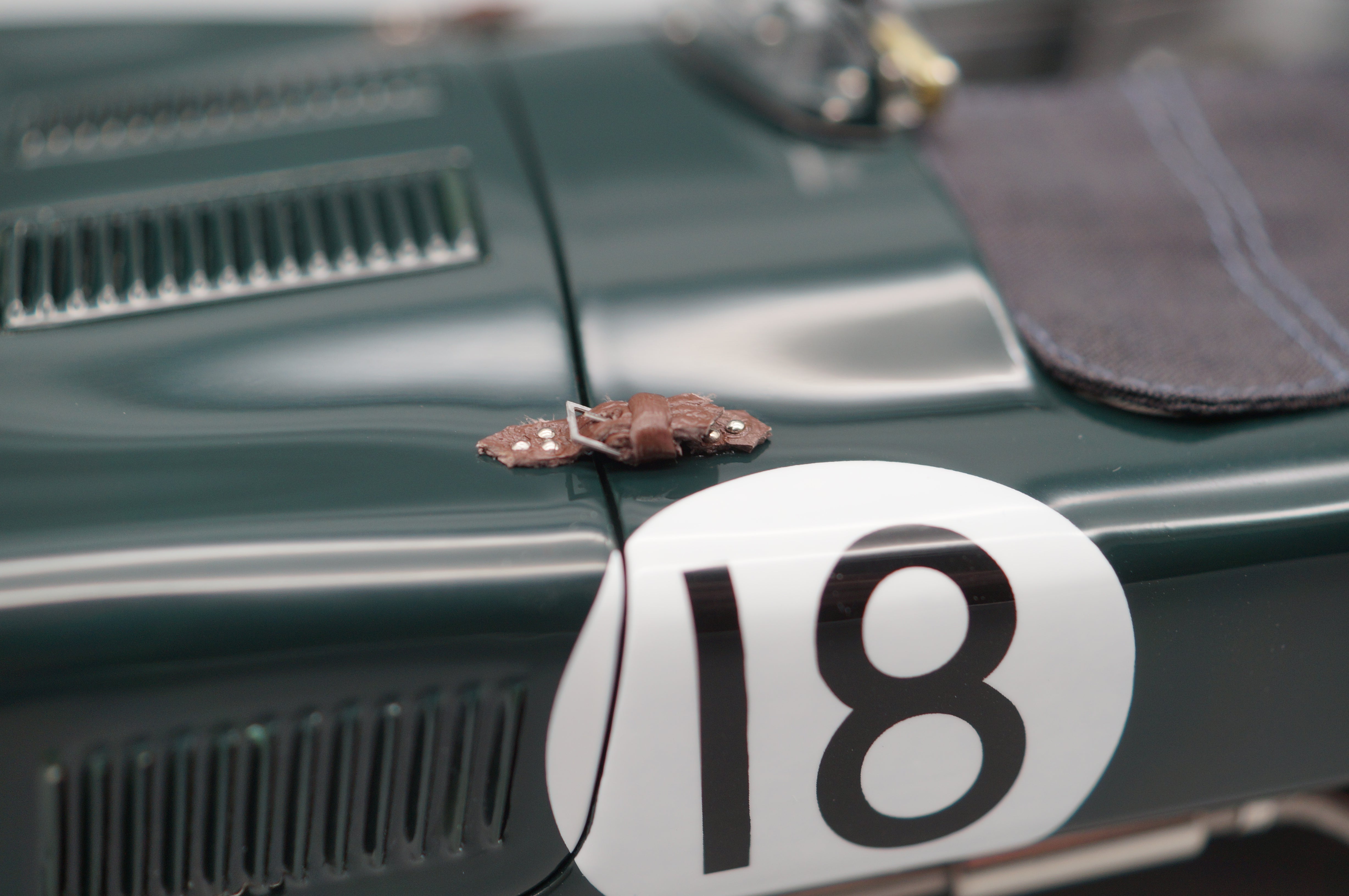
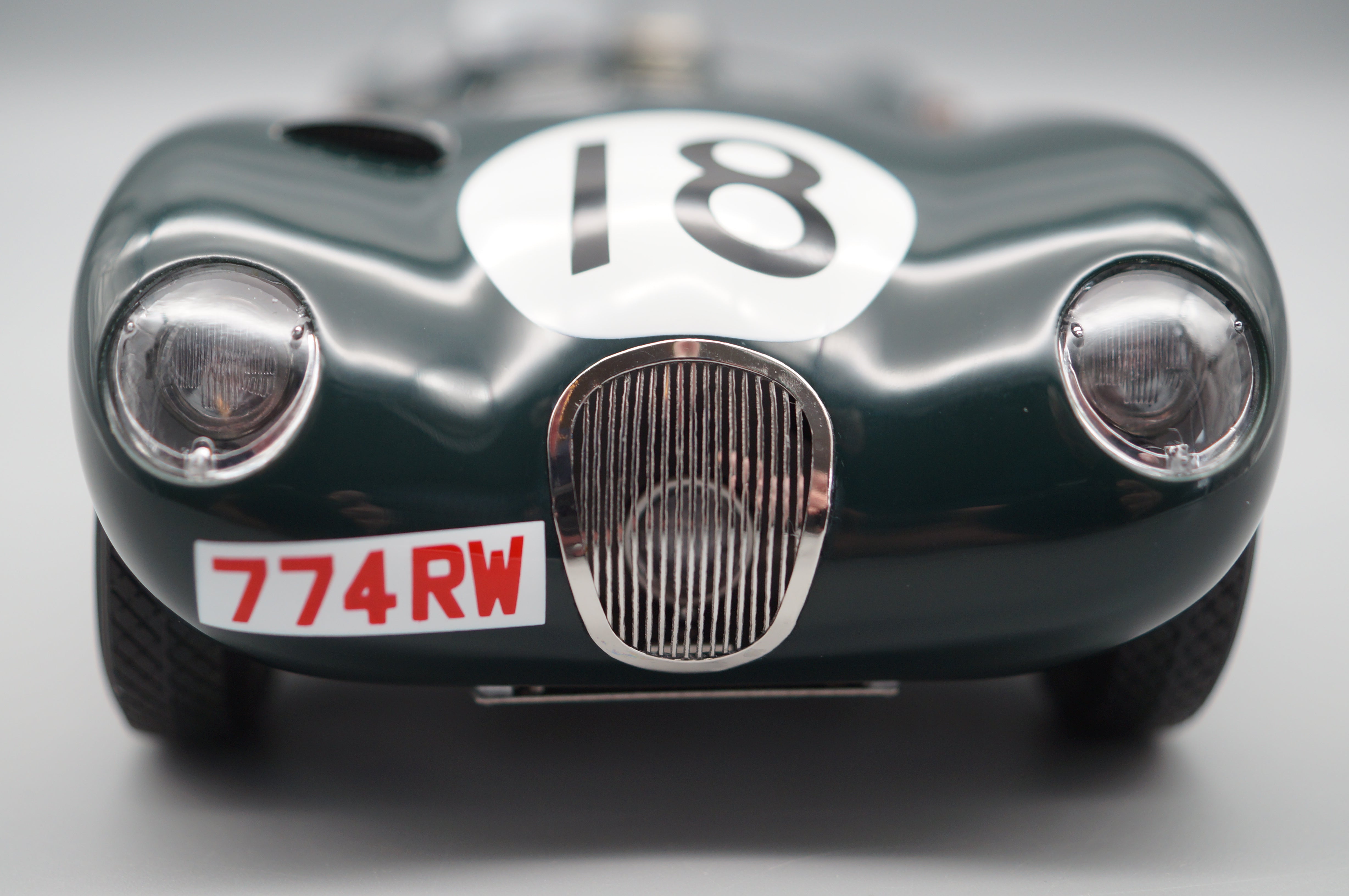
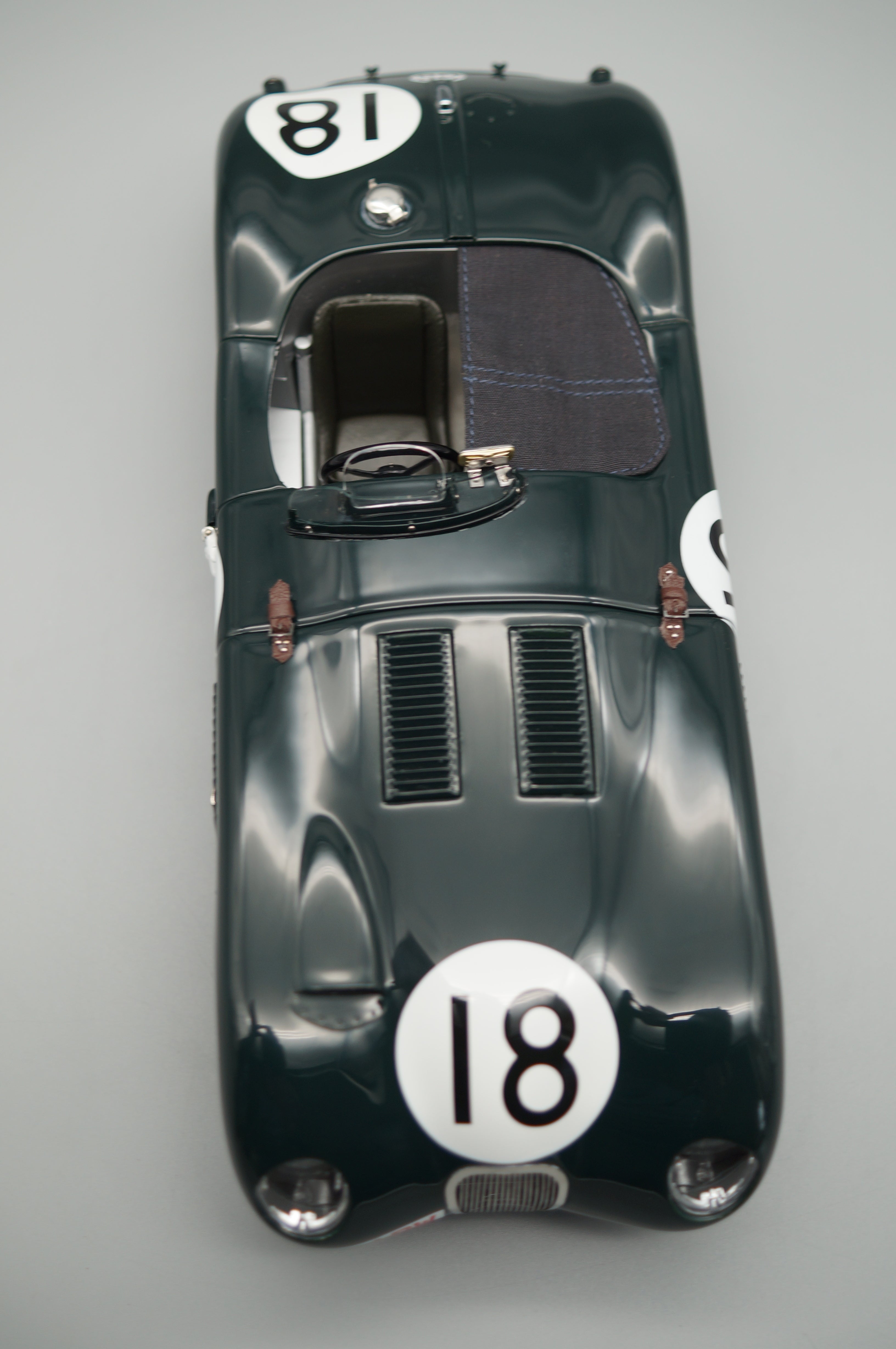
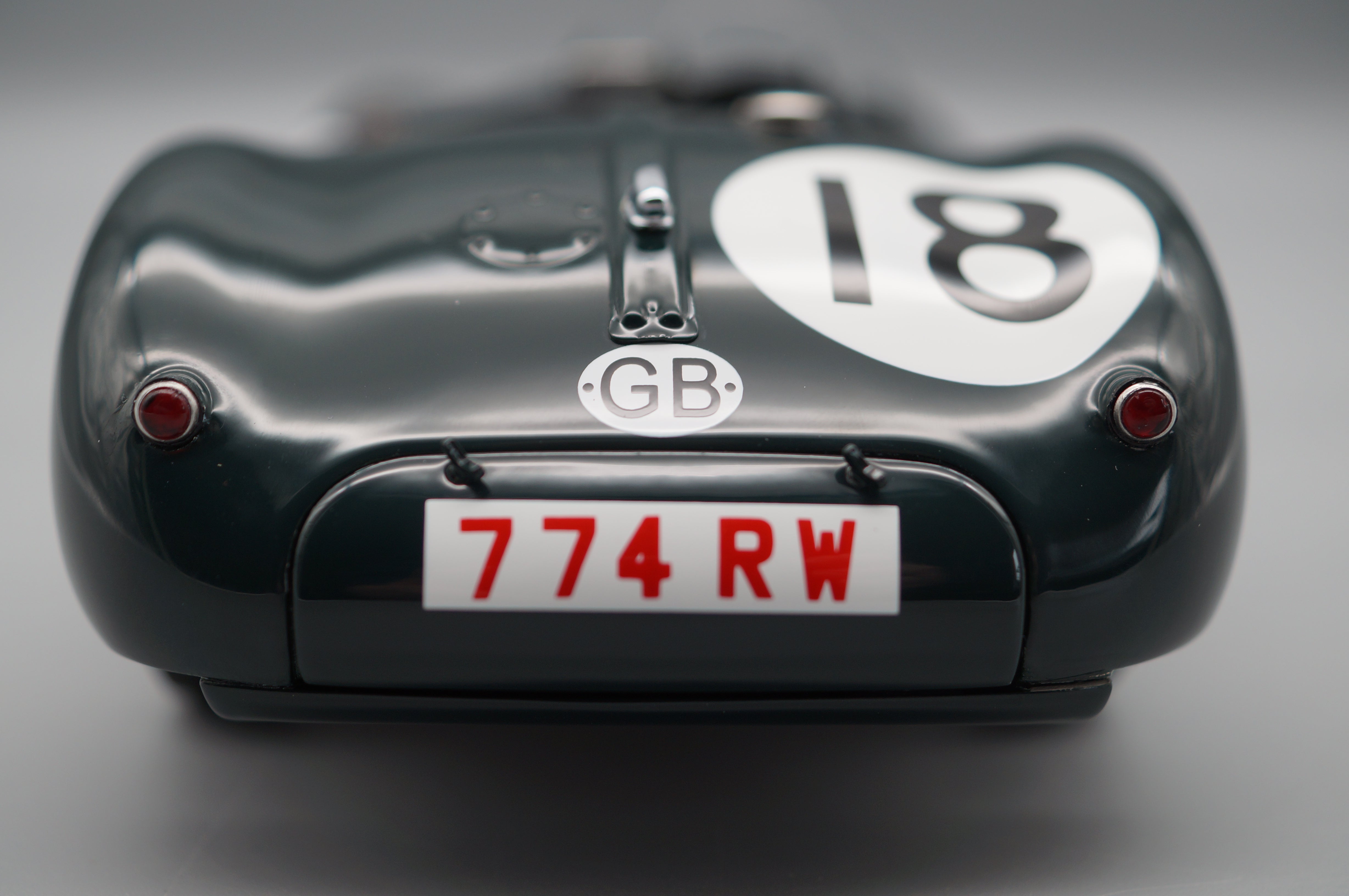
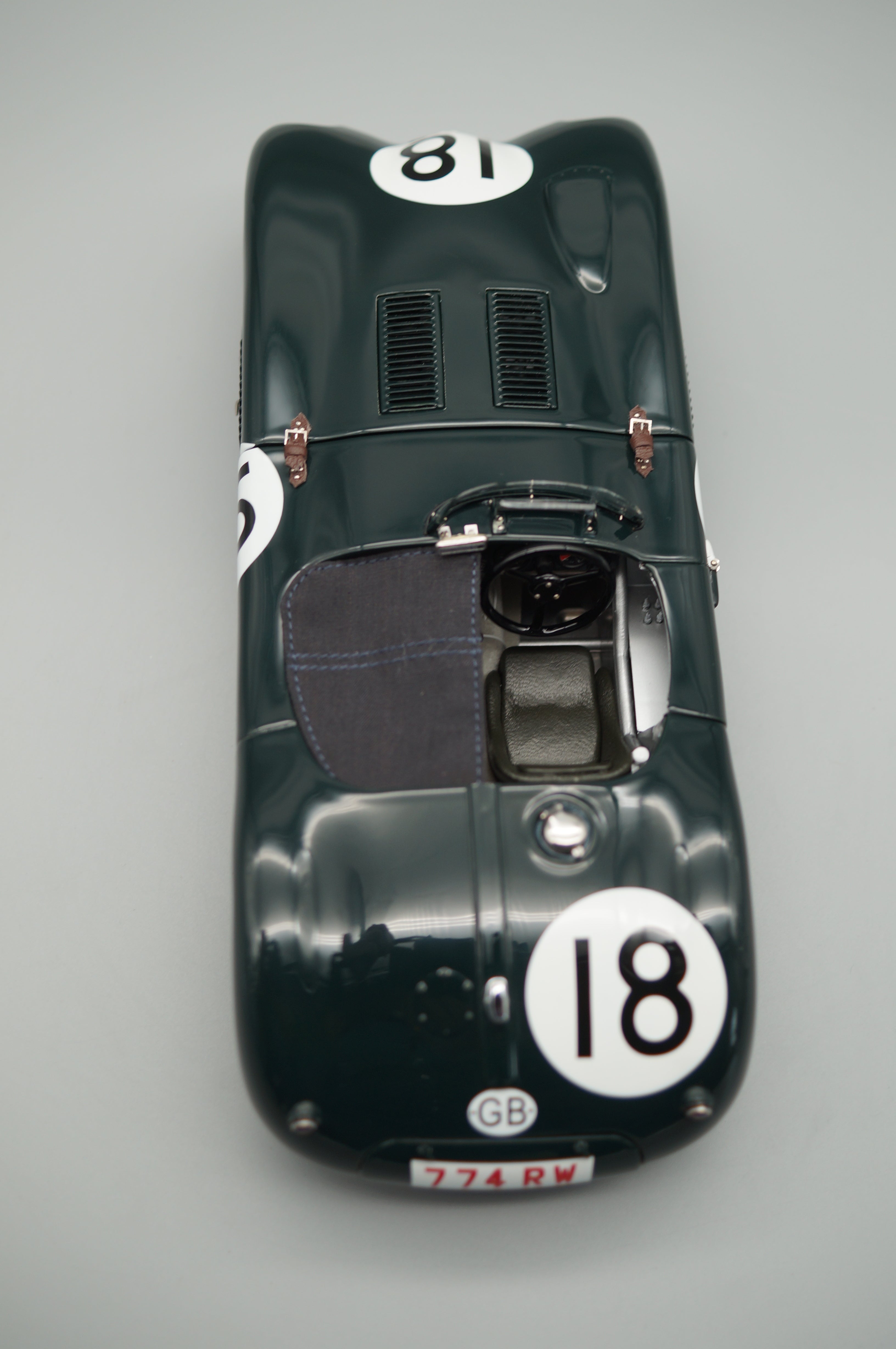
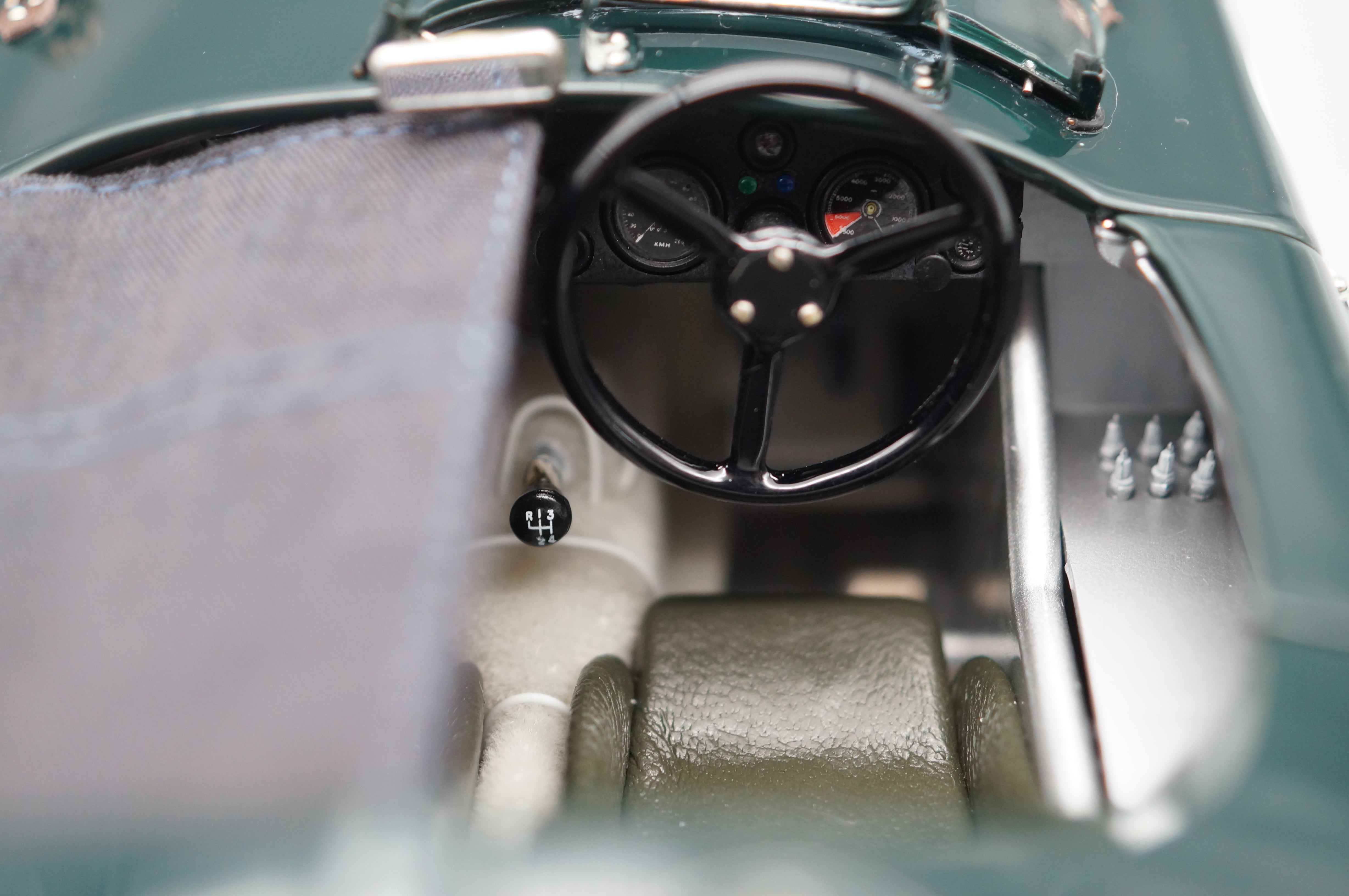

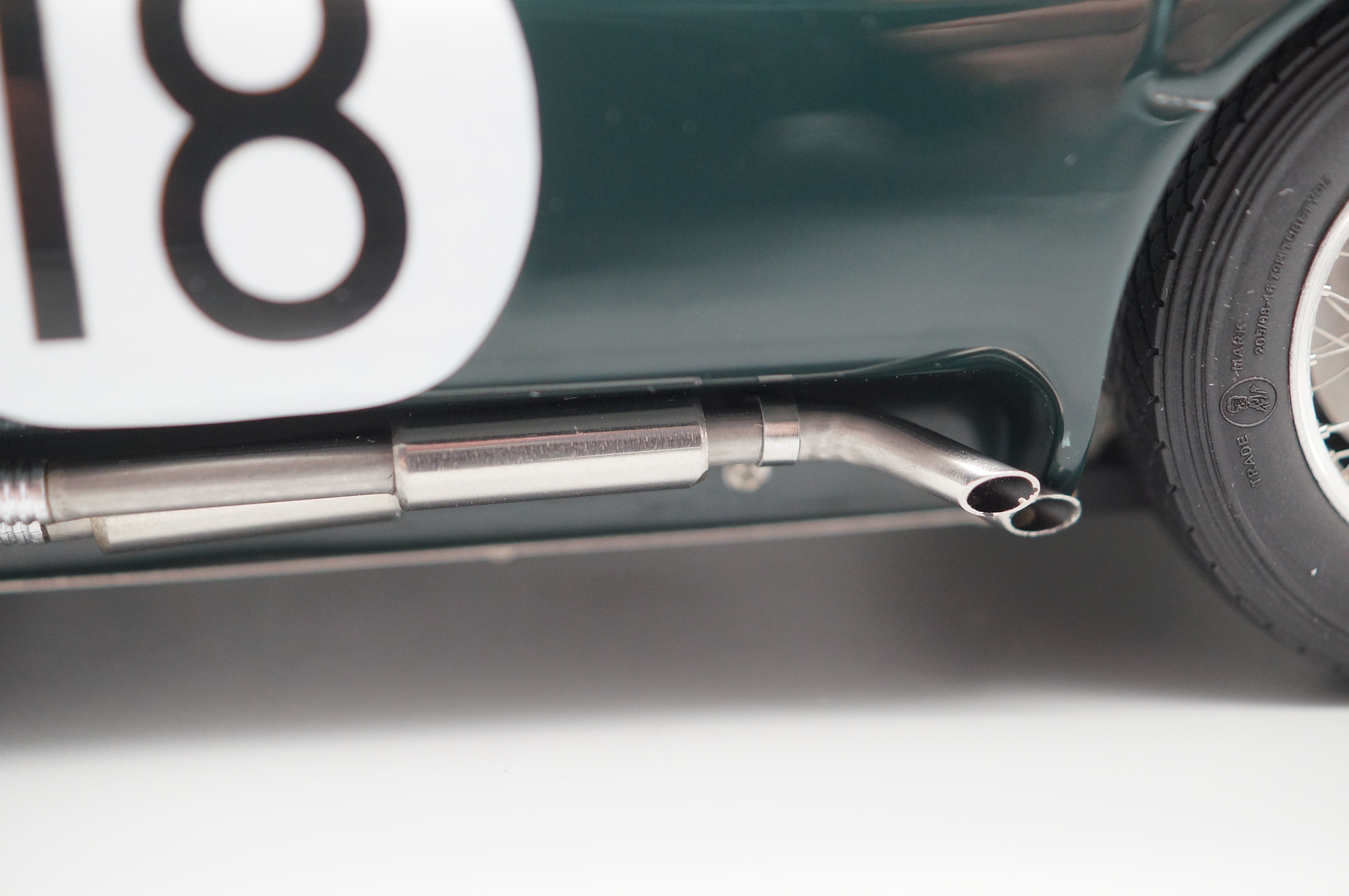
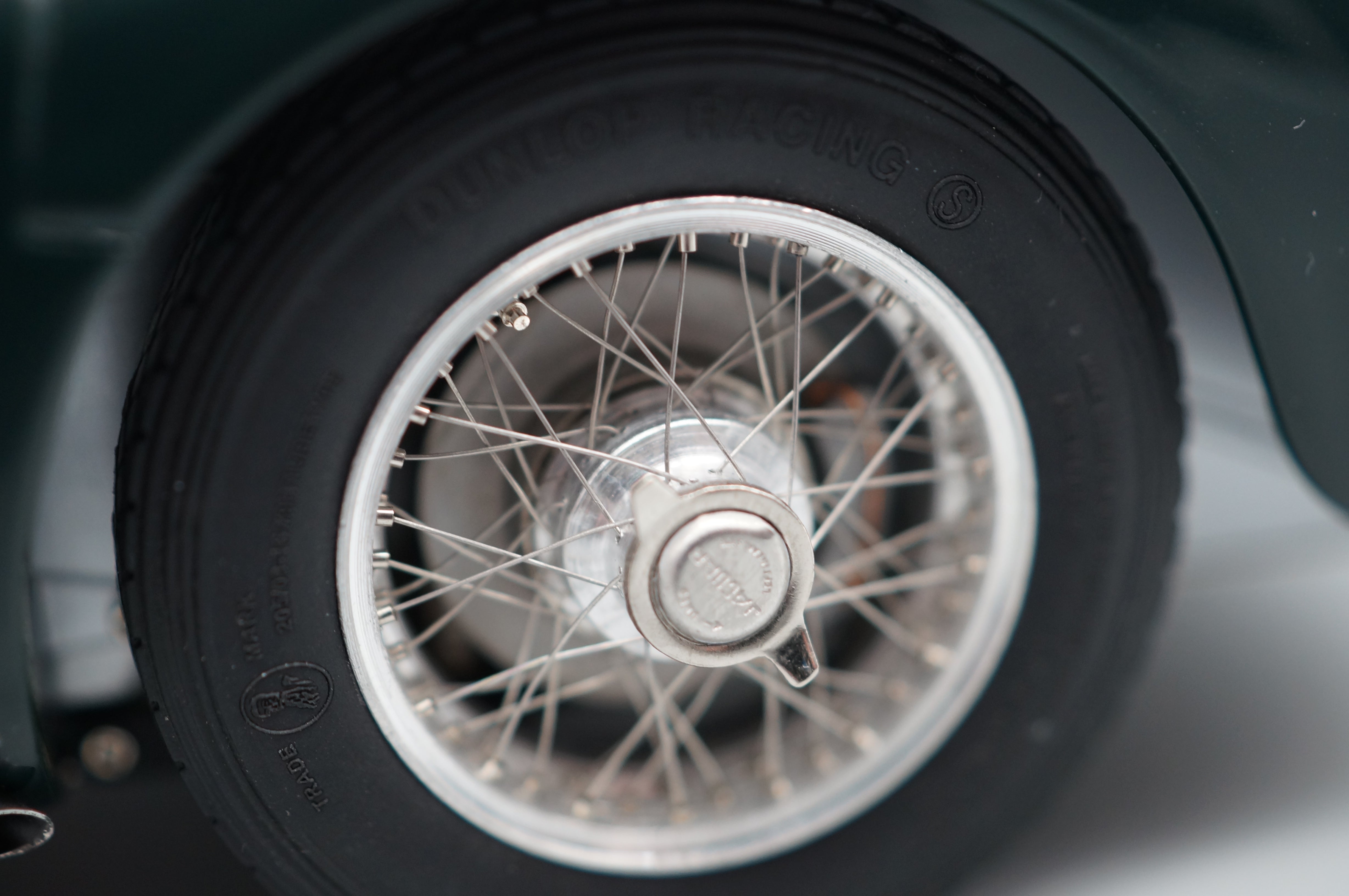
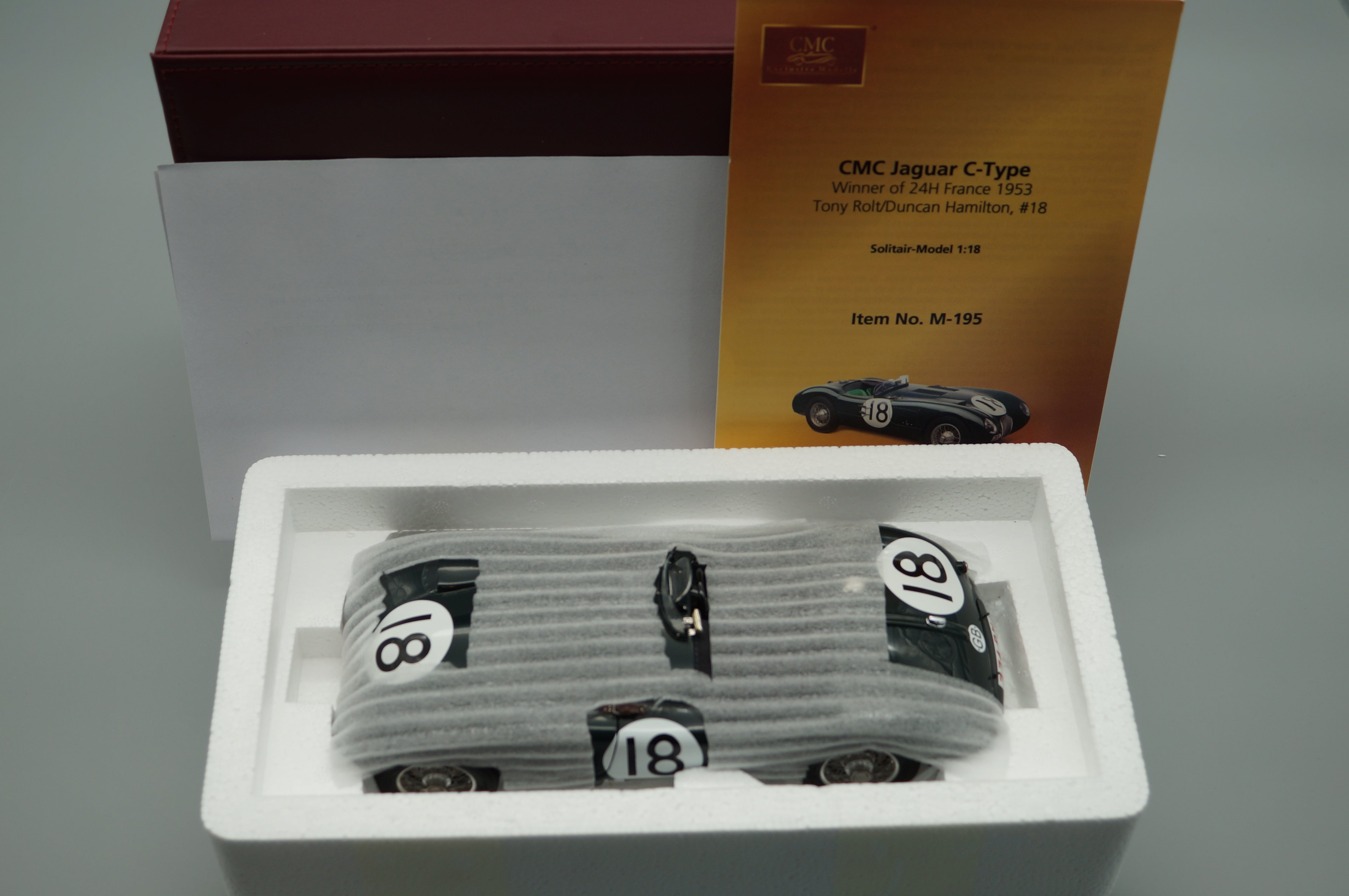
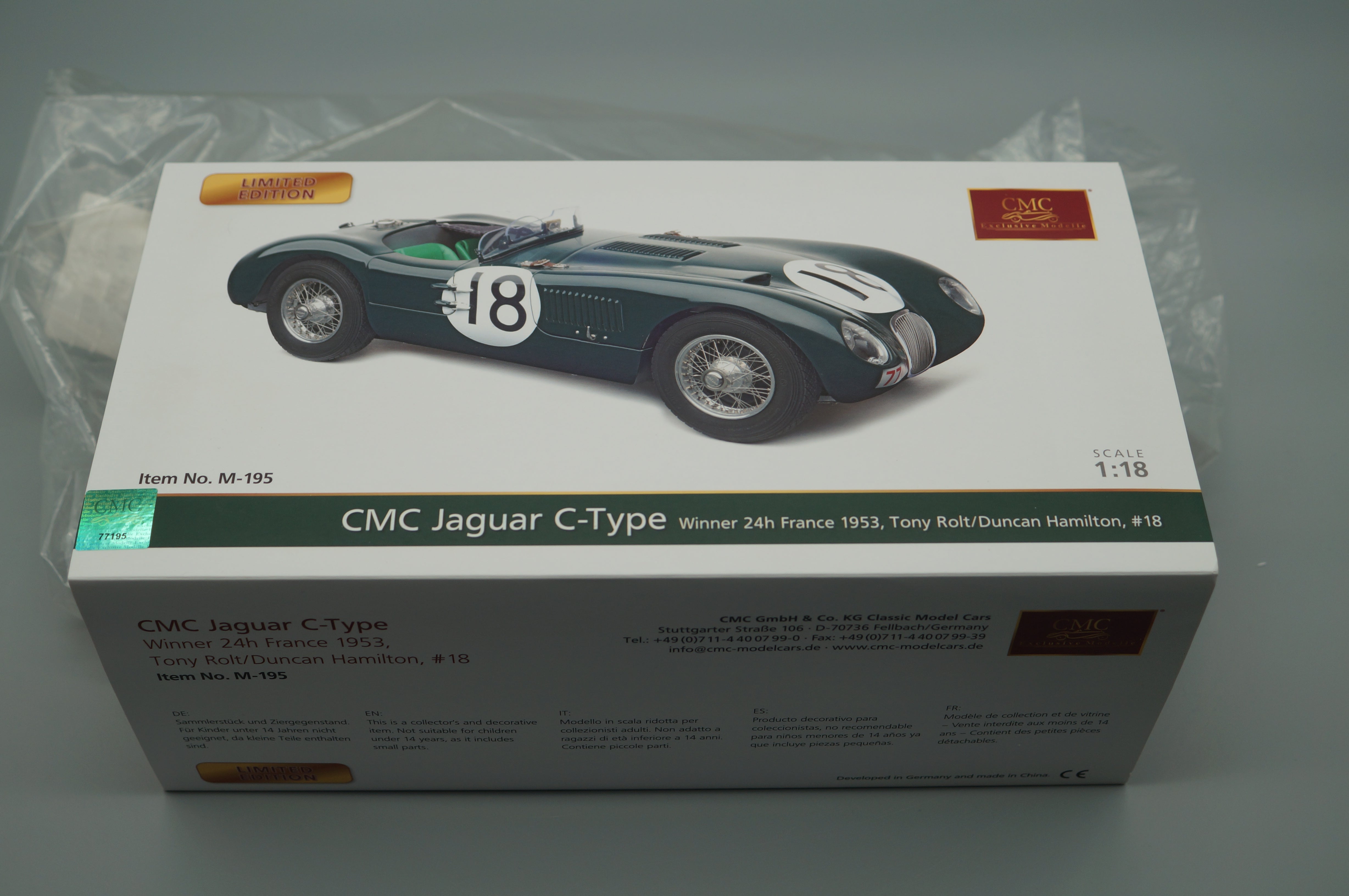
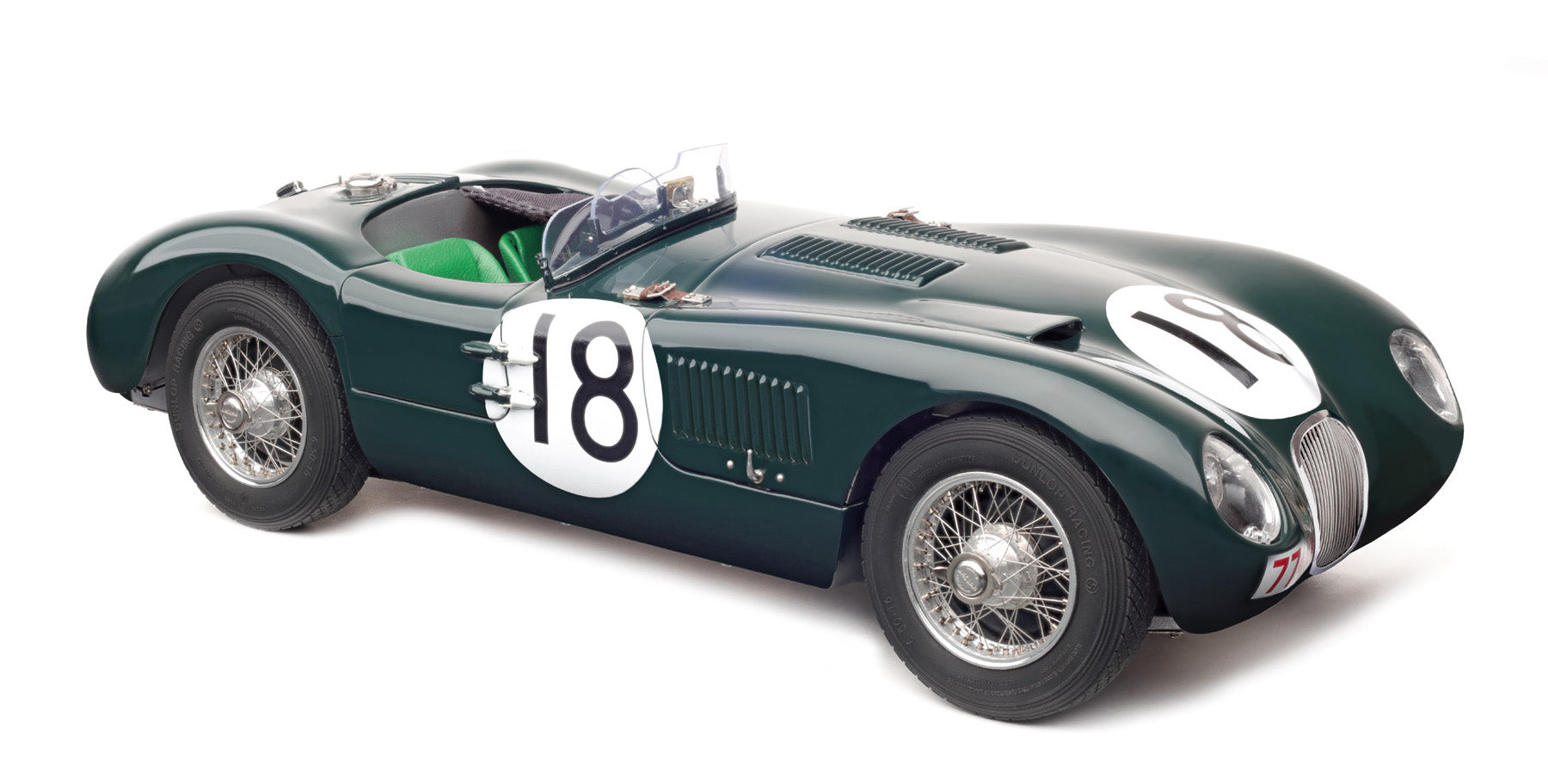

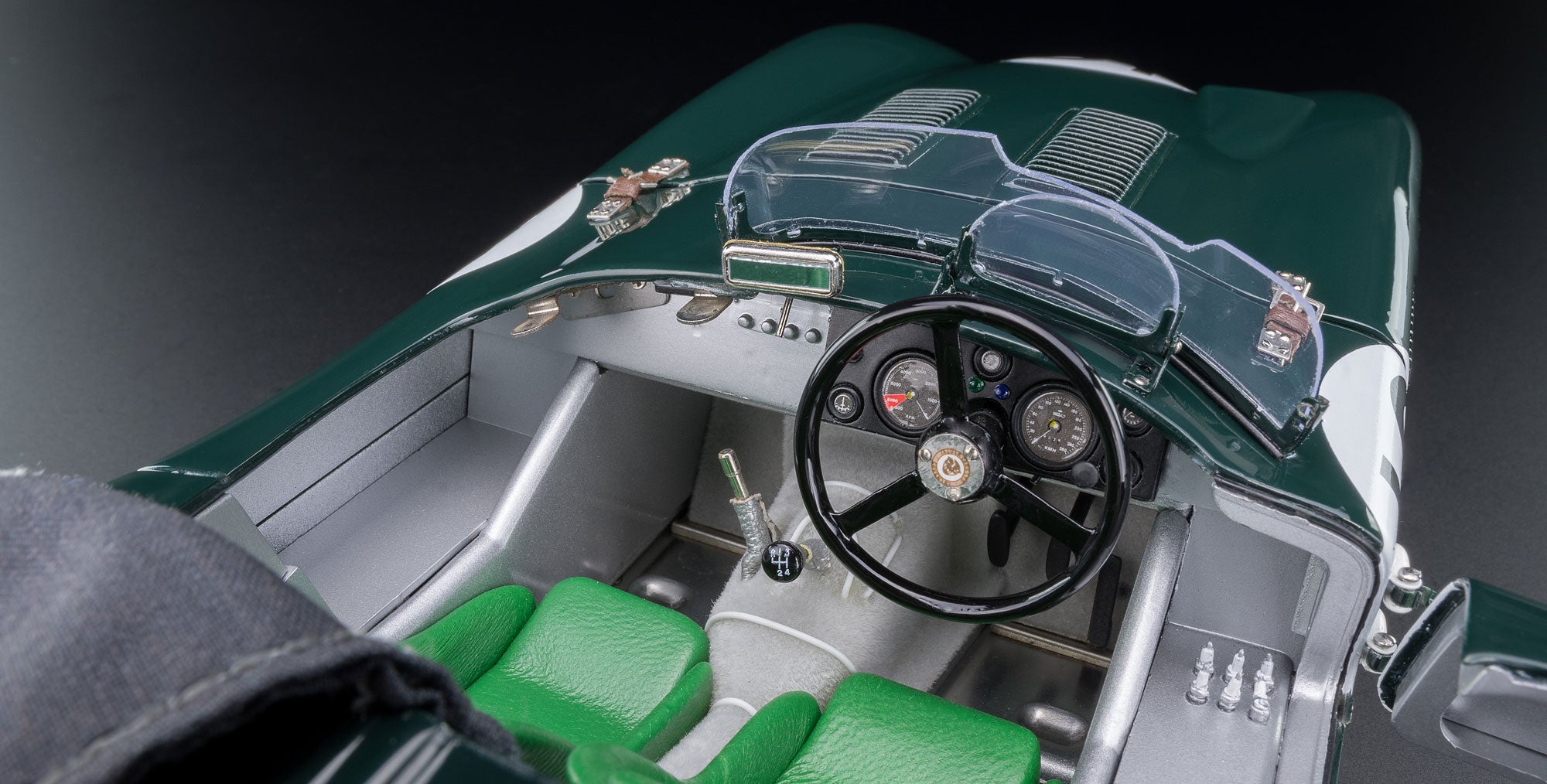
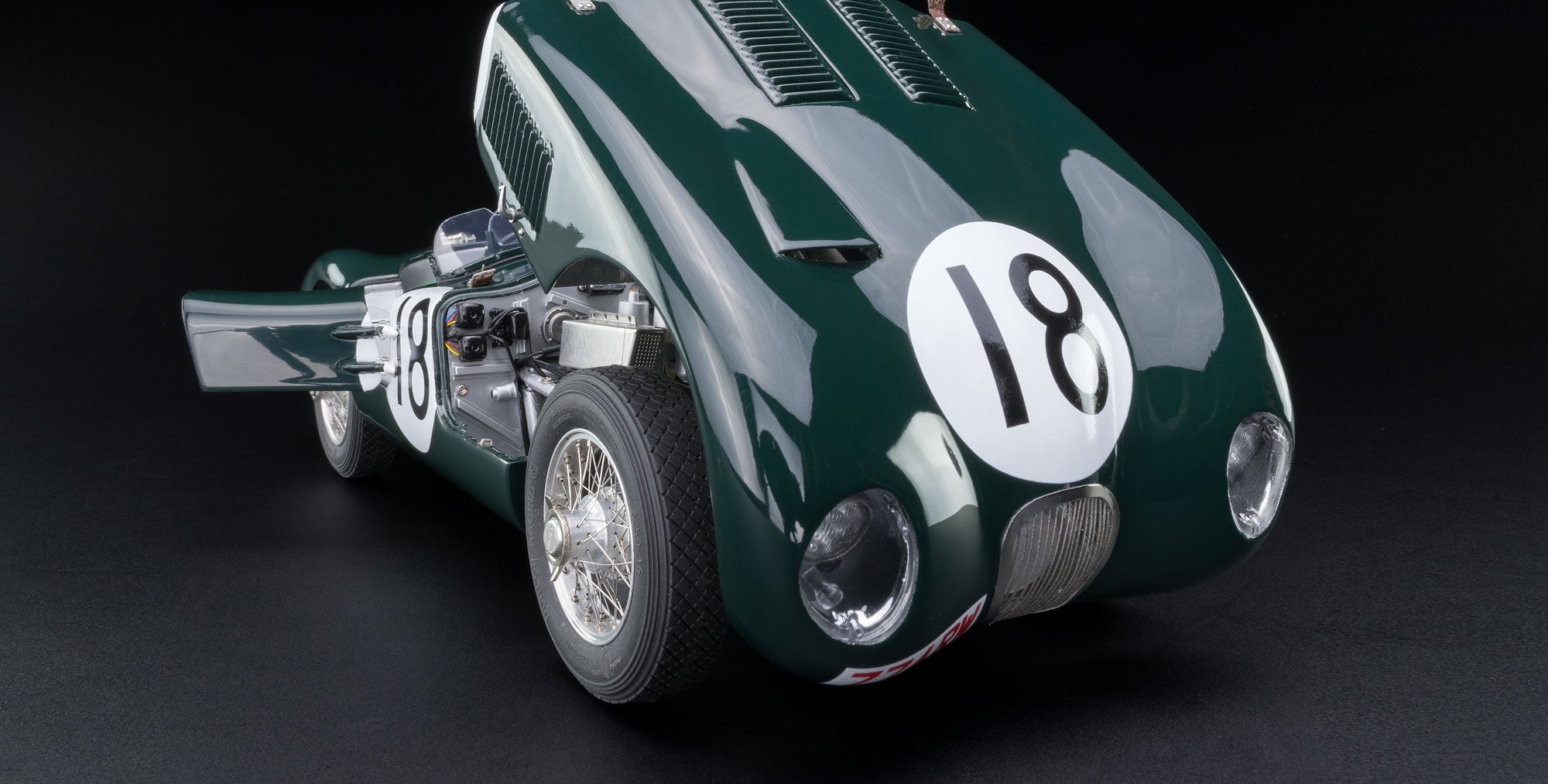

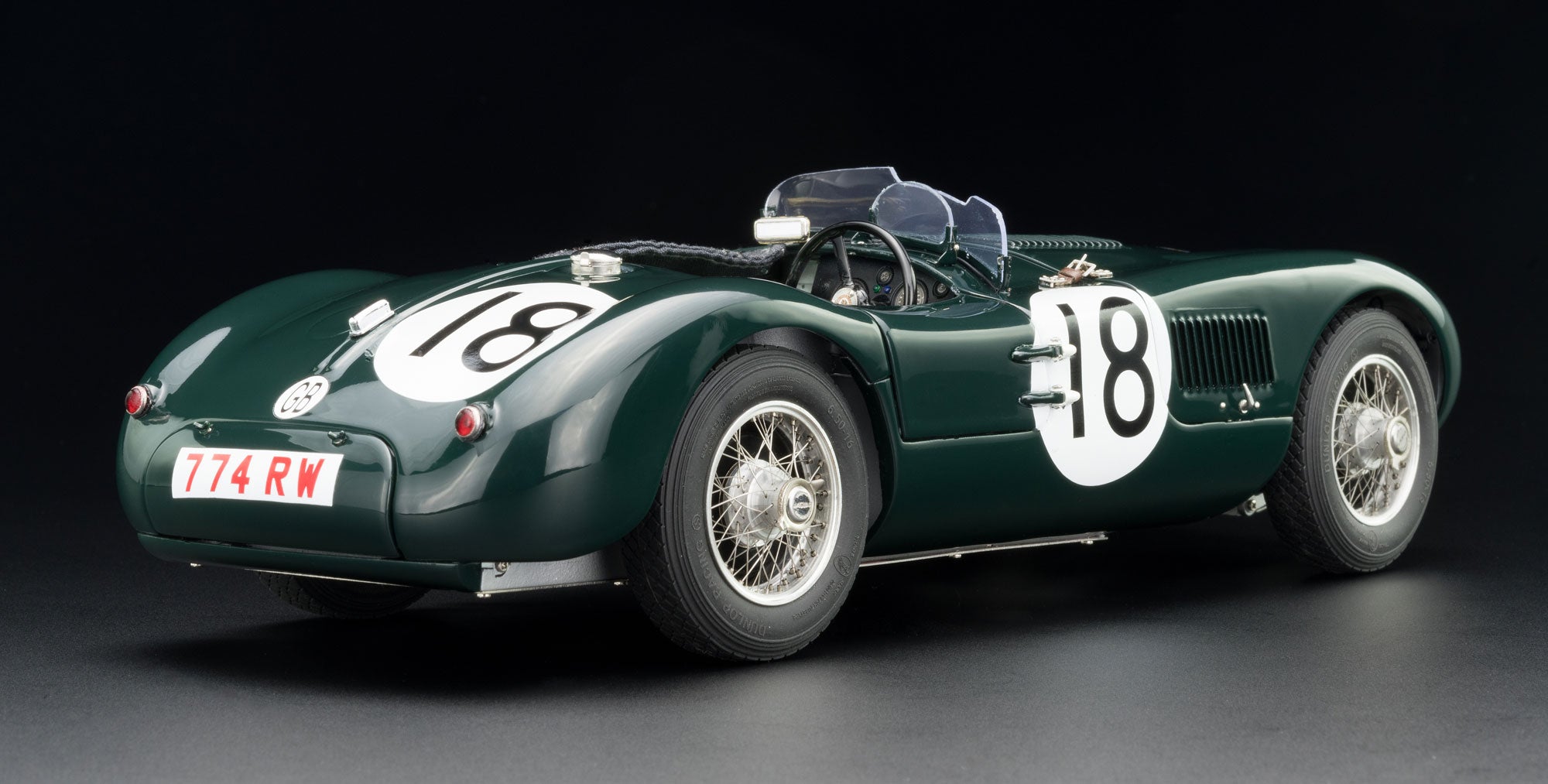
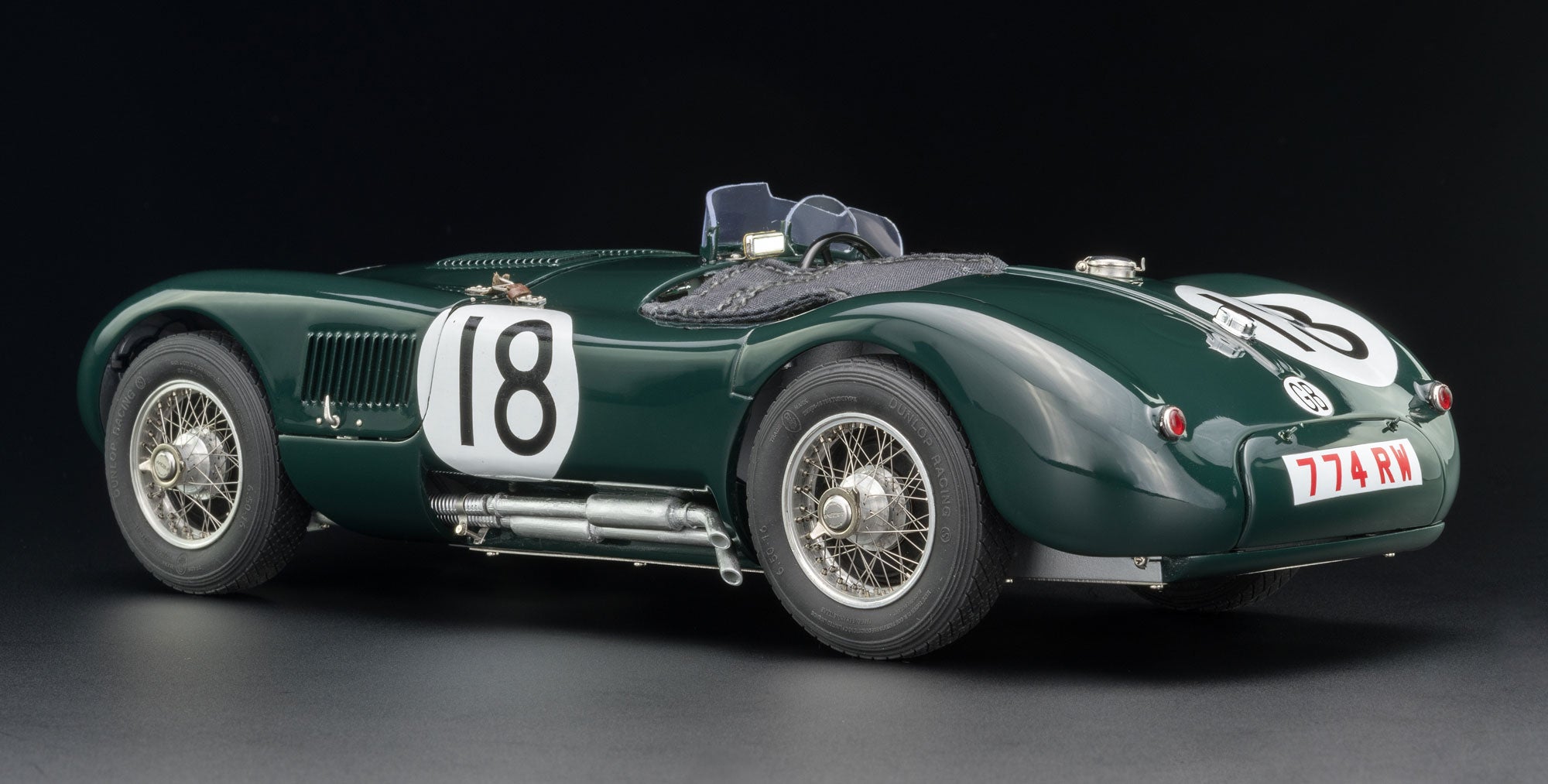
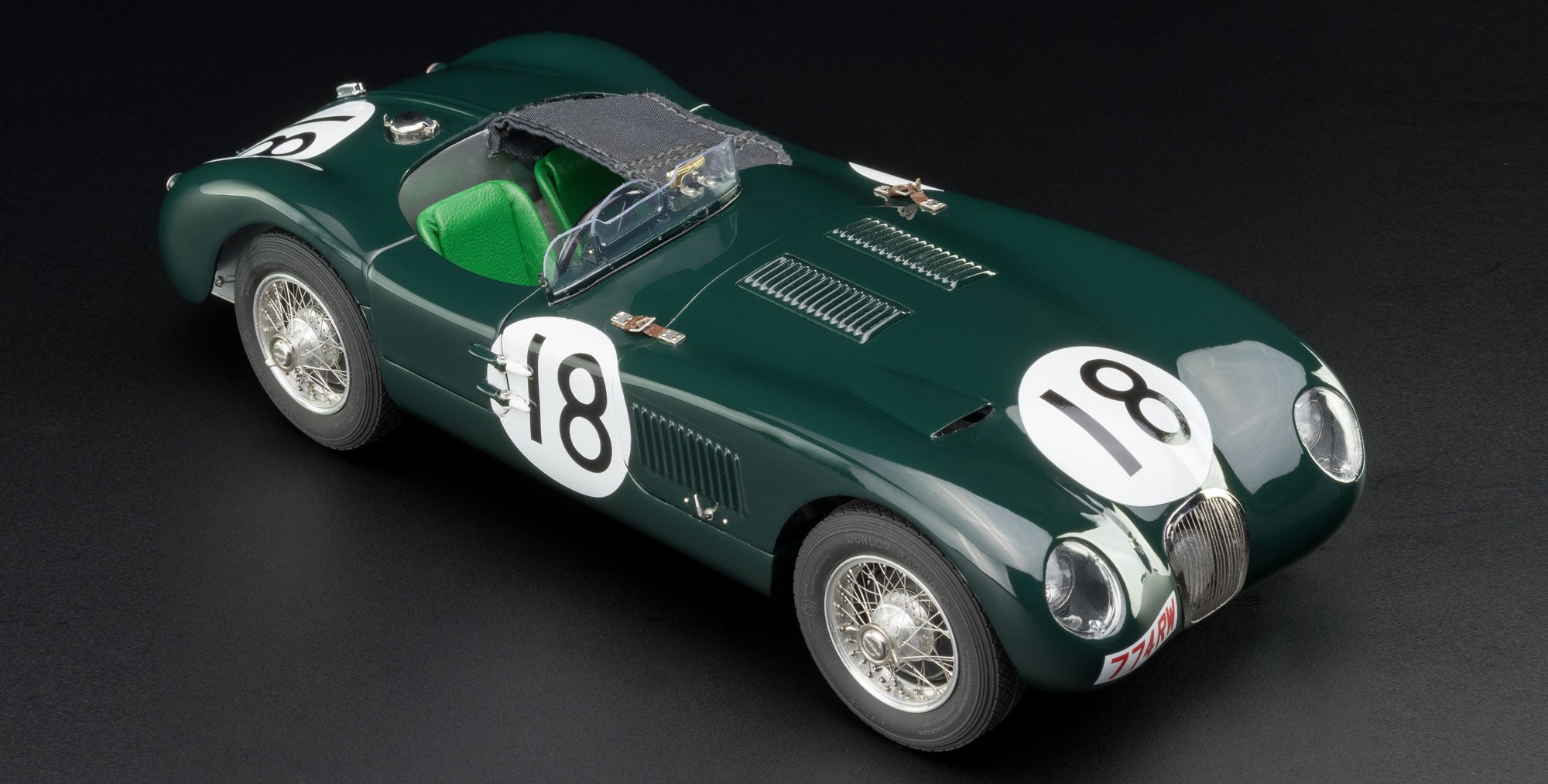
1:18 Jaguar C-Type #18 24h Le Mans winner 1953 Rolt/Hamilton CMC M-195 LE 1.500 - pre-owned-
Der Verkauf unterliegt der Differenzbesteuerung gem. § 25a UStG (Gebrauchtgegenstände/Sonderregelung). Ein gesonderter Ausweis der Umsatzsteuer für gebrauchte oder wiederaufbereitete Gegenstände ist nicht zulässig.

Description
The 1953 24 Hours of France winning car, the triumphant winner. The Jaguar racing team presented the victory to HM Queen Elizabeth, who had been enthroned that year, and the car was left to rot on the Jaguar factory grounds, inexplicably. CMC commemorates the 1953 triumph with this C-Type and is offering this winning car, number 18, as a 1:18 scale model.
After a surprisingly convincing victory for the C-Type in 1951 and a disastrous failure for the team a year later, extensive preparations for Le Mans 1953 were meticulously carried out. Jaguar Cars Ltd. sent a total of four vehicles to France. The reward for the invested effort: game, set, and match. On June 14, 1953, at 4:00 p.m., the Jaguar boys reached the finish line – all of the C-Types entered crossed the finish line, with their first, second, fourth, and ninth places.
Winner of the 24H of France, Tony Rolt / Duncan Hamilton #18 , Jaguar Racing Team
The endurance classic was Jaguar's primary goal from the beginning, as they were aware of the marketing impact of a Le Mans victory. Accordingly, Jaguar focused on high reliability and good handling during the development of the C-Type. Jaguar balanced the aerodynamics for high top speeds. Chief engineer Bill Heynes did a great job. The chassis was redesigned as a tubular space frame. Jaguar mounted a thin aluminum body with a single door for the driver on top. The design was conceived by the gifted engineer Malcolm Sayer, who just a few years earlier had been designing aircraft for the British Royal Air Force.
The cockpit was protected only by a small racing windshield. The space inside can only be described as cramped due to the bracing of the tubular space frame. However, the Jaguar drivers found all the necessary instruments in the cockpit of the C-Type, including spare spark plugs and tools for repairs during the race. After the factory team's total retirement in 1952, four C-Types were completely rebuilt for the following season: The reworked engines received three Weber 40DCO3 twin carburettors, the body was now made of very thin aluminum sheet, and the rubber fuel tank was derived from aircraft construction. Jaguar used the newly developed Dunlop disc brakes and a servo amplifier for brake pressure assistance for the first time. For improved roadholding at Le Mans, the rear axle received additional support, and the front axle a stronger anti-roll bar. The effort paid off at the end of the race. The Jaguar boys won and also finished second, fourth, and ninth. William Lyons dedicated this triumphant march to the newly enthroned Queen Elizabeth. Her Majesty returned the favor in her own way and knighted the Jaguar boss in the spring of 1956.
Model description:
- Metal precision model made of more than 1,150 parts, hand-assembled.
- Foldable and lockable hood
- True-to-original replica of the six-cylinder in-line engine with all add-on units and complete wiring/cabling
- Metal exhaust pipes
- Wishbone front axle with oil-pressure shock absorbers made of metal
- Torsion bar suspension in longitudinal arrangement
- Rigid rear axle with trailing arms and oil-pressure shock absorbers made of metal
- Torsion bar suspension in transverse arrangement
- Handcrafted, painted stainless steel grille
- Detailed replica of the cooling system
- Detailed laying of oil and fuel lines
- Movable tank cap
- Driver's door with authentically reproduced hinges for opening
- Cockpit with leather-covered driver and passenger seats
- Perfectly designed spoked wheels with hand-drawn and nippled stainless steel wire spokes
- Screwable wheel center locks with authentic right/left thread
- Brilliant paintwork in original color
- Positioning of start number 18 using pad printing
Technical data of the original vehicle
- Racing car built on a tubular space frame
- Body made of thin aluminum sheet
- Six-cylinder in-line engine with 3.4 litres displacement
- 2 valves per cylinder, controlled by two overhead camshafts
- Dry sump lubrication
- Mixture preparation with three Weber 40DCO3 flat-flow twin carburettors
- Ignition with coil and capacitor, one spark plug per cylinder
- Four-speed gearbox flanged to the engine
| Perfomance: | 230 hp at 5,500 rpm |
| Engine capacity: | 3,442 cc |
| Bore x stroke | 83 x 106 mm |
| Top speed: | 260 km/h (depending on rear axle ratio) |
| Wheelbase: | 2,438 mm |
| Total length: | 3,988 mm |
| Total width: | 1,638 mm |
| Track width front/rear | 1,295 / 1,295 mm |
| Total height: | 1,081 mm |
| Empty weight | 940 kg (2072 lb.) |
CMC Legal Disclaimer
The use of racing team and/or driver names, symbols, starting numbers, and/or descriptions is solely for reference purposes. Unless otherwise stated, it does not imply that the CMC scale model is a product of any of these racing teams/drivers or endorsed by any of them.
Notice
The 1953 24 Hours of France winning car, the triumphant winner. The Jaguar racing team presented the victory to HM Queen Elizabeth, who had been enthroned that year, and the car was left to rot on the Jaguar factory grounds, inexplicably. CMC commemorates the 1953 triumph with this C-Type and is offering this winning car, number 18, as a 1:18 scale model.
After a surprisingly convincing victory for the C-Type in 1951 and a disastrous failure for the team a year later, extensive preparations for Le Mans 1953 were meticulously carried out. Jaguar Cars Ltd. sent a total of four vehicles to France. The reward for the invested effort: game, set, and match. On June 14, 1953, at 4:00 p.m., the Jaguar boys reached the finish line – all of the C-Types entered crossed the finish line, with their first, second, fourth, and ninth places.
Winner of the 24H of France, Tony Rolt / Duncan Hamilton #18 , Jaguar Racing Team
The endurance classic was Jaguar's primary goal from the beginning, as they were aware of the marketing impact of a Le Mans victory. Accordingly, Jaguar focused on high reliability and good handling during the development of the C-Type. Jaguar balanced the aerodynamics for high top speeds. Chief engineer Bill Heynes did a great job. The chassis was redesigned as a tubular space frame. Jaguar mounted a thin aluminum body with a single door for the driver on top. The design was conceived by the gifted engineer Malcolm Sayer, who just a few years earlier had been designing aircraft for the British Royal Air Force.
The cockpit was protected only by a small racing windshield. The space inside can only be described as cramped due to the bracing of the tubular space frame. However, the Jaguar drivers found all the necessary instruments in the cockpit of the C-Type, including spare spark plugs and tools for repairs during the race. After the factory team's total retirement in 1952, four C-Types were completely rebuilt for the following season: The reworked engines received three Weber 40DCO3 twin carburettors, the body was now made of very thin aluminum sheet, and the rubber fuel tank was derived from aircraft construction. Jaguar used the newly developed Dunlop disc brakes and a servo amplifier for brake pressure assistance for the first time. For improved roadholding at Le Mans, the rear axle received additional support, and the front axle a stronger anti-roll bar. The effort paid off at the end of the race. The Jaguar boys won and also finished second, fourth, and ninth. William Lyons dedicated this triumphant march to the newly enthroned Queen Elizabeth. Her Majesty returned the favor in her own way and knighted the Jaguar boss in the spring of 1956.
Model description:
- Metal precision model made of more than 1,150 parts, hand-assembled.
- Foldable and lockable hood
- True-to-original replica of the six-cylinder in-line engine with all add-on units and complete wiring/cabling
- Metal exhaust pipes
- Wishbone front axle with oil-pressure shock absorbers made of metal
- Torsion bar suspension in longitudinal arrangement
- Rigid rear axle with trailing arms and oil-pressure shock absorbers made of metal
- Torsion bar suspension in transverse arrangement
- Handcrafted, painted stainless steel grille
- Detailed replica of the cooling system
- Detailed laying of oil and fuel lines
- Movable tank cap
- Driver's door with authentically reproduced hinges for opening
- Cockpit with leather-covered driver and passenger seats
- Perfectly designed spoked wheels with hand-drawn and nippled stainless steel wire spokes
- Screwable wheel center locks with authentic right/left thread
- Brilliant paintwork in original color
- Positioning of start number 18 using pad printing
Technical data of the original vehicle
- Racing car built on a tubular space frame
- Body made of thin aluminum sheet
- Six-cylinder in-line engine with 3.4 litres displacement
- 2 valves per cylinder, controlled by two overhead camshafts
- Dry sump lubrication
- Mixture preparation with three Weber 40DCO3 flat-flow twin carburettors
- Ignition with coil and capacitor, one spark plug per cylinder
- Four-speed gearbox flanged to the engine
| Perfomance: | 230 hp at 5,500 rpm |
| Engine capacity: | 3,442 cc |
| Bore x stroke | 83 x 106 mm |
| Top speed: | 260 km/h (depending on rear axle ratio) |
| Wheelbase: | 2,438 mm |
| Total length: | 3,988 mm |
| Total width: | 1,638 mm |
| Track width front/rear | 1,295 / 1,295 mm |
| Total height: | 1,081 mm |
| Empty weight | 940 kg (2072 lb.) |
CMC Legal Disclaimer
The use of racing team and/or driver names, symbols, starting numbers, and/or descriptions is solely for reference purposes. Unless otherwise stated, it does not imply that the CMC scale model is a product of any of these racing teams/drivers or endorsed by any of them.


